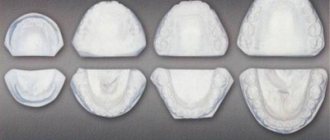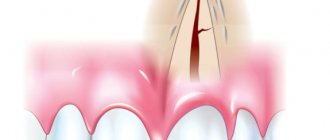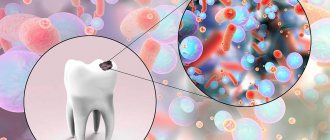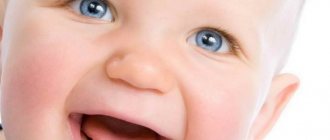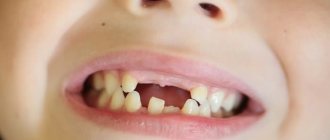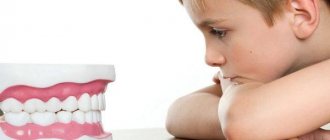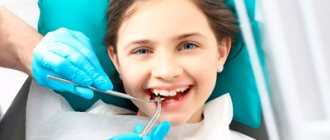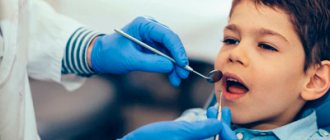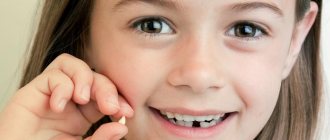- Treatment of caries and pulpitis of milk teeth
- Treatment of caries and pulpitis for children and adolescents under 16 years of age
- Children's prevention and hygiene
- Tooth extraction for children
- Anesthesia for children
If we talk about tooth extraction in children, then first of all we will talk about the removal of milk teeth for dental reasons and during the period of physiological change of teeth to permanent ones.
Permanent teeth have to be removed in children for the same reasons as in adults, and you can read about this in our article on tooth extraction.
How does baby teeth fall out?
The replacement of baby teeth with permanent ones is a physiological process. By the age of 3, a child grows 20 milk teeth in his mouth, which differ in structure from permanent teeth. They have thinner enamel and walls, and more branched roots. Then, gradually, the roots of baby teeth begin to dissolve. At the age of 5-6 years, baby teeth begin to loosen and fall out in the order in which they appeared, and in their place permanent teeth grow from the rudiments. The period of formation of a permanent dentition lasts up to 13-14 years and the appearance of 7 teeth - the second molars - ends. Healthy baby teeth and natural, timely replacement of teeth guarantee the child healthy teeth in his permanent dentition. Therefore, it is best if baby teeth fall out on their own and do not require additional doctor intervention, but this does not always happen.
What to do with your child's first lost baby tooth?
Parents who are not particularly superstitious keep them as a reminder of their child’s childhood. To do this, you can sew a special bag or buy a beautiful box. In addition, sometimes parents make a special album for the baby, in which they describe the most significant moments in the baby’s life, including the change of teeth. Moreover, they can be put into such an album and stored for many years.
If you are superstitious enough, you can prepare a whole ritual for your child, which the child will definitely remember for the rest of his life. Perhaps your son or daughter, upon becoming adults, will pass on the tradition to their children. So, below you will find the most popular and interesting signs that will help you make the right decision.
Is it possible to remove a baby tooth at home?
The human body is programmed to independently change teeth without complications. If the child does not have dental or general diseases, then the natural loss of a baby tooth is the most desirable scenario. You don't need to do anything to do this. Just when a child’s tooth is loose, pay extra attention to hygiene, because brushing a child’s loose teeth on their own is painful. Make sure that the child does not touch the tooth with his hands - it can cause an infection.
How to help a baby tooth fall out on its own?
The simplest and most effective way is to give your child something hard to chew on, such as an apple. It is better to refuse threads and other fancy devices.
If you decide to help the process a little and remove the interfering tooth yourself, clamp it with a sterile napkin, try to turn it a little around its axis and remove it. Do not “twist” the tooth with force or put pressure on it, so as not to damage the bone and soft tissue. After removal, have your child bite on a sterile cotton swab for 10-15 minutes. There is no need to rinse your mouth after removal; do not feed your child solid food or hot foods for several days.
If you suspect that the tooth has not been completely removed, or the child complains that there is a sharp edge in the hole that “scratches” - contact your dentist as soon as possible.
Option 1 – give the tooth to the mouse
In various cultures there is a ritual when a lost baby tooth should be given to a mouse, which in return will bring the child some kind of souvenir at night. Children willingly believe in this belief and strive to quickly remove a loose tooth in order to receive a reward for this. If the removal takes place in a doctor's office, the dentist may even wrap it in a napkin and give it to the child, who will exchange it for real value at home.
The ritual of giving a tooth to a mouse is that the child is told a funny story about how at night a little mouse will come running under the pillow where the tooth will lie and take it for itself, leaving a nice gift. Children are madly looking forward to this day, because in the morning they find surprises under their pillows.
When a tooth is placed under the pillow, the child is asked to say in a simple whisper: “Mouse-mouse, take my milk tooth and bring me a real one, strong and even.” Or they ask you to bring something tasty as a gift. There are no people indifferent to this ritual.
From a psychological point of view, this trick works great, forming a “tooth loss – reward” relationship in the subcortex. In the future, the child will not be afraid to visit dentists, knowing that any procedure will be rewarded.
When should a pediatric dentist remove a baby tooth?
There are cases when a baby tooth needs to be removed without waiting for natural loss.
If the tooth is not loose, it CANNOT be removed at home; this can ONLY be done by a pediatric dentist. Temporary teeth have long roots, underneath them there are the rudiments of permanent teeth that can be damaged, and baby teeth themselves are fragile and easy to break. Tooth extraction is a mini-operation, for which you need to contact a specialist.
In what cases does a baby tooth need to be removed?
- The tooth is damaged by 50% or more by caries and cannot be restored.
- Serious complications of caries have led to the fact that the tooth is a source of infection that cannot be cured - periodontitis, periostitis, phlegmon.
- A fistula has formed on the gum next to the tooth.
- A cyst was found on the root of a baby tooth.
- The tooth is injured (severely chipped, twisted by a blow, broken and scratches the mucous membrane)
- The tooth wobbles for a long time, but holds tightly and cannot fall out on its own, which prevents the child from eating.
- The loose tooth became infected and inflammation began.
- A permanent tooth has already erupted next to the milk one, but the milk tooth is not going to fall out.
- If, according to the timing, the baby tooth should have fallen out a long time ago and a permanent one should have grown in its place, but nothing happens. This indicates a delay in root resorption. In order to understand how to proceed, an X-ray diagnosis of the presence of a permanent tooth germ is needed. If there is a germ, then it is better to remove the baby tooth to cause the growth of a permanent one.
- Sometimes a tooth needs to be removed for orthodontic reasons.
Treat or remove?
To this question, the simplest answer that comes to mind first is to remove it, since this will help solve all the problems in one visit to the dentist’s office. However, if you dig deeper, it will be obvious that the simplest solution is not always the right one.
The consequences of premature loss of a baby tooth are quite serious:
- Earlier removal of temporary teeth leads to the fact that the remaining ones try to fill the vacated space and, in short periods of time, move towards the empty space. Because of this, molars can erupt in the wrong places and lead to severe malocclusions, which will require complex, lengthy and expensive orthodontic treatment.
- After the removal of a baby tooth, the bone tissue of the jaw ceases to experience the necessary load, which is why the rate of its growth and development decreases. Subsequently, such processes can lead to the fact that when the molars erupt, they will not have enough space, and they will grow crookedly and overlap each other.
- Long-term absence of chewing teeth and insufficient processing of food during chewing can cause the development of chronic diseases of the gastrointestinal tract.
- For a school-age child, the absence of front baby teeth can become a serious psychological problem, which will complicate relationships with peers and negatively affect the formation of personality.
It is because of these consequences that in modern pediatric dentistry, when it comes to removing or treating, if possible, preference is given to the second option.
What anesthesia is used to remove baby teeth in children?
If we are talking about removing a baby tooth that is already loose, without complications and signs of inflammation, then such removal does not require pain relief.
If a problematic baby tooth is removed or it sits firmly in the jaw, then local anesthesia is used for children, sometimes with sedation.
Tooth extraction under anesthesia (general anesthesia) is possible in special clinics where a team of anesthesiologists works. From a medical point of view, in most cases there is no need to remove baby teeth under anesthesia. This is usually due to the fear of the child and his parents. The use of anesthesia is justified only in cases of serious mental disorders or complex illnesses, because it has more dangers than benefits .
What are the dangers of early removal of baby teeth?
If a temporary tooth is forced to be removed before its natural loss by more than a year, then we are talking about early removal. This situation provokes malocclusion and improper development of the entire dental system, including delayed jaw growth.
Neighboring teeth strive to take the place of their distant counterpart, and all of them are displaced.
adjacent teeth and their roots, antagonist teeth also move into the resulting free space. As a result, permanent teeth can erupt chaotically and even outside the dentition. In the future, such a problem will require long-term orthodontic treatment.
In addition, earlier removal of chewing teeth leads to a redistribution of the load on the front teeth, which, in turn, begin to collapse.
Therefore, it is so important to strive to keep all baby teeth in their places for as long as possible, preferably until the time of their natural replacement.
What role do baby teeth play?
It was not by chance that nature provided for the replacement of temporary teeth with molars. Baby teeth help the baby switch to a regular adult diet, stimulate the development of jaw bone tissue and create favorable conditions for the teething of a permanent set. If there had not been such a change, then the molars simply would not fit on a small child’s jaw and would not be able to fully perform their immediate functions.
What to do if a child has a baby tooth removed early?
If trouble happens and the child has one or more milk teeth removed ahead of schedule, it is necessary to take measures to restore the dentition and preserve the space after the extracted teeth.
For this purpose, special dentures are used - removable plates with artificial teeth or special orthodontic structures are installed. In any case, after early removal, you must take the child for a consultation with an orthodontist - he will suggest the right solution. For more information about the treatment of malocclusion problems in children, read: “Children’s orthodontics - correcting the bite in children.”
When should a baby tooth not be removed?
There are situations when it is IMPOSSIBLE to remove a baby tooth, so as not to aggravate the child’s condition or provoke serious complications.
- If a child suffers from an acute infectious disease, then removal should be postponed until complete recovery.
- If there is an acute inflammatory process in the oral cavity - stomatitis, gingivitis, candidiasis (thrush), then removal is carried out after the acute stage of the disease subsides.
- If the tooth is located in the area of any tumor, removal is carried out together with the tumor and in the hospital.
- Teeth removal is carried out with caution in small patients suffering from diseases of the central nervous system, heart, kidneys, and blood.
Indications and contraindications
Even though children's teeth will fall out naturally from the primary occlusion, the reasons for removing them prematurely must be quite compelling. Indications for such manipulation are strictly limited:
- Advanced forms of caries, in which the crown is so damaged that there is no technical possibility to restore it.
- Situations when the permanent tooth has already erupted, but the milk tooth sits firmly in its place and interferes with the normal growth of the root rudiment.
- The presence of a chronic fistulous tract on the child’s gums that cannot be cured by other methods.
- Severe forms of inflammation (pulpitis or periodontitis), when there is a high risk of spread of the pathological process and death of the rudiments of permanent teeth.
- Delayed resorption of the root of a temporary tooth, which interferes with the normal eruption of the permanent crown.
It is possible to remove a loose baby tooth in situations where it causes significant discomfort to the child and interferes with normal conversation and eating.
Removal is contraindicated in the following cases:
- The presence of an acute inflammatory process in the child’s mouth: gingivitis, stomatitis, candidiasis, herpetic rashes.
- If there are signs of infectious diseases of childhood: scarlet fever, whooping cough, chicken pox, as well as tonsillitis, flu or even a common acute respiratory infection.
- If the child suffers from diseases that interfere with normal blood clotting: hemophilia, leukemia.
- If the child is in serious condition and has heart failure, heart defects, or epilepsy.
- If there is a hematoma in the area of the tooth that requires removal.
In each specific case, the dentist decides whether to remove the temporary tooth or try to treat it.
«
What to do after a child’s tooth extraction?
- Make sure that the child spits out the tampon that was placed after removal after 15-20 minutes.
- After removal, a blood clot should remain in the hole, which protects it from inflammation. There is no need to clean the hole from blood, rinse the mouth, the child should not touch the removal site with hands or objects.
- If the child has been given anesthesia, explain to the child that he should not bite on the numb side until the feeling of cold and pins and needles goes away.
- Feed your baby only warm, soft food for several days.
- Maintain good hygiene; brushing your teeth is not only possible, but also necessary, with a soft toothbrush, carefully avoiding the extraction site.
- If the tooth extraction was difficult, then try to limit the child’s physical activity so as not to provoke bleeding.
How to properly prepare a child for tooth extraction in pediatric dentistry?
- A brave child is one who is familiar with the place and situation, so parents need to try to ensure that the first visit to the dental clinic is not associated with treatment, much less tooth extraction and pain. Go with your child to the dental clinic for preventive examinations, children's parties, which we regularly hold, take your child with you when you go to have your teeth treated.
- A good, cozy clinic is not a dream today, but an accessible reality. Go to the clinic yourself without your child, meet the doctor. The atmosphere should be calm, the space should be thought out for small patients. And, of course, no screaming or crying behind office doors.
- Never frighten your child with the dentist or doctors in general, and do not be afraid of them yourself - children subtly sense the mood of their parents.
- Ask your doctor whether it is better to leave your child alone or be present during the procedure. NEVER leave your child alone at the dentist's office if this is their first appointment with the dentist.
- Do not shame your child in the dentist's chair, do not blackmail him with a gift or threaten him with punishment. Introduce him to the doctor and help establish contact between them, using the child’s natural curiosity - he should be interested, not scared.
Why can't you save your first teeth?
Some parents, after exchanging teeth with their children, are not ready to part with their teeth and prefer to keep them. But in many cultures this is unacceptable, since there is a risk of magical influence on the child’s life through his part. Why you can’t keep your child’s baby teeth – the signs are as follows:
- Ill-wishers can steal and use teeth in their rituals, which will harm the health of their owner.
- A dead tooth has dead energy, which should not be adjacent to living people, as it violates the aura.
- The first teeth that fall out should not be stored in a glass container as they may attract evil spirits.
Also, our ancestors were extremely afraid and careful that their children’s milk teeth would not be swallowed by an animal. It was believed that in place of the fallen one, not an even root analogue, but an animal fang would grow.
No one will (and has no moral right) to judge you if you decide to save your child’s first teeth. Modern mothers embroider metrics, where they attach tags from the maternity hospital, first curls, pacifiers and baby’s teeth. Such a reminder will allow you to remember those very pleasant moments that our memory tries so hard to forget. It is especially important to remember a child’s childhood when he has already grown up and started his own family. Memories will help you travel back for a short time to 20-30 years ago and remember all the good things that were associated with the baby and his life.
Tags: baby tooth, omen
About the author: DrZubastik
- Related Posts
- Why do children need restoration of baby teeth?
- 10 foods that are good for your teeth
- What to do if your tooth hurts during quarantine?
« Previous entry
